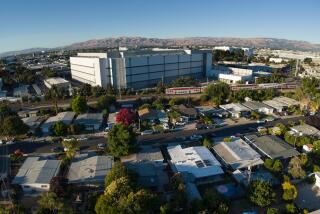Sony Readies for Big Surge in U. S. Market : Plant Expansion Based on Expected High Demand for Color Monitors
- Share via
The importance of Sony’s giant Rancho Bernardo manufacturing plant to its U. S. market strategy was underscored late last month when the Japanese consumer electronics giant announced it will shift production of its color video monitors there from Japan by the end of this year.
Although Sony shipped only about 150,000 of its high-resolution monitors to U. S. computer manufacturers last year from its plants in Japan, an analyst said last week that the demand for Sony’s monitors could grow tenfold by 1992 from a single customer: Apple Computer.
Sony’s color monitor has been a standard option of Apple’s Macintosh II personal computer since it was introduced in 1987. Of the 190,000 Mac IIs sold last year, about 60% “went out with a Sony monitor,” said Sohail Malik, an industry analyst with Dataquest, a high-technology market research firm in San Jose.
Could Grow Substantially
But demand for the Sony monitor could increase to 1.6 million units from Apple alone if the Mac II penetrates the business PC market as quickly as Malik expects. Other customers of Sony’s color monitors include Sun Microsystems, International Business Machines and NeXT, Steven Jobs’ new computer company.
If demand for the color monitors increases to the level forecasted by Malik, production volume required to meet it could approach that of Sony’s Trinitron color televisions. Close to 1.5 million Sony Trinitron TVs are now produced yearly at Sony’s Rancho Bernardo and Tijuana plants.
The growth in demand for color monitors is predicated not only on the business community’s acceptance of the Mac II but also on the switch by more personal computer owners to color monitors instead of the more widely used monochrome video displays.
“It makes sense for Sony to do some manufacturing there from two different angles. First, the Japanese have a history of manufacturing in depressed currency markets (relative to the yen), so it makes sense from a financial standpoint,” Malik said.
“It also makes sense for Sony to be near its customers. In 1988, they had a supply problem fulfilling some parts of its computer market, namely the Macintosh market,” Malik said.
Although a clear victor so far in the Macintosh market, Sony is an also-ran with Japanese competitors NEC, Mitsubishi and Hitachi for other slices of the $1-billion-plus color PC monitor market. So far, NEC is the largest supplier of color monitors to IBM, Malik said.
“What Sony has to do is maintain their market share in the Macintosh color market and grow its share in other microcomputer markets. I think this move is intended to facilitate that,” Malik said.
Clint Michaelis, president of Sony Manufacturing Co. of America, the San Diego-based U. S. subsidiary of Sony, refused to comment on sales projections for the color monitor. Nor would Michaelis confirm that Apple, Sun Microsystems and IBM are Sony’s customers.
To accommodate color video monitor production, Sony will build a 150,000-square-foot plant on 32 acres next to its existing plant in Rancho Bernardo. Sony acquired the parcel last year to handle growth. The addition will be highly automated and cost about $10 million to build, Michaelis said.
The color monitor plant will employ up to 200 once in full operation. Sony now employs about 1,500 workers at its Rancho Bernardo plant and 1,200 at its new Tijuana plant.
Michaelis made it clear that any plant expansion required to supply color monitors to U. S. “industrial” customers or to satisfy “consumer” market demand for Sony televisions in will be done at Rancho Bernardo.
“As we look at the future, we are looking at both the development of the consumer market and the industrial side of the market,” Michaelis said. “They are both
developing, and at some point we’ll have to expand to meet our needs. Our long-range goal is to produce both (products) in the United States . . . to support this business as it grows and develops.”
Transferred All Manufacturing
Sony, which in 1972 became the first Japanese consumer electronics manufacturer to build a major plant in the United States, has moved virtually all its television manufacturing for the U. S. market to its Rancho Bernardo and new Tijuana operations over the past two years.
The company now makes 13-, 19- and 32-inch color TV sets at its 260,000-square-foot Tijuana plant and the 20- and 27-inch sets at the Rancho Bernardo plants. Formerly, the 13- and 19-inch models were shipped here from Japan. Sony began making a 32-inch model only this year.
Besides color televisions, Sony is also manufacturing 3.5-inch floppy disk drives and its NEWS workstation computer model at the Rancho Bernardo plant.
Over the past year, Sony has become a big-time industrial tenant in San Diego, leasing 100,000 square feet of warehouse space on Otay Mesa and 300,000 square feet at the old Sanyo plant on Kearny Mesa to accommodate increased production.
More to Read
Inside the business of entertainment
The Wide Shot brings you news, analysis and insights on everything from streaming wars to production — and what it all means for the future.
You may occasionally receive promotional content from the Los Angeles Times.










